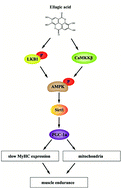Ellagic acid enhances muscle endurance by affecting the muscle fiber type, mitochondrial biogenesis and function
Abstract
Ellagic acid (EA) is a natural polyphenolic compound, which shows various effects, such as anti-inflammatory and antioxidant effects and inhibition of platelet aggregation. In this study, we investigated the effect of EA on muscle endurance and explored its possible underlying mechanism. Our data showed that EA significantly improved muscle endurance in mice. EA increased the protein level of slow myosin heavy chain (MyHC) I and decreased the protein level of fast MyHC. We also found that the AMP-activated protein kinase (AMPK) signaling pathway was activated by EA. Finally, our data indicated that EA could increase mitochondrial biogenesis and function by increasing the content of mitochondrial DNA (mtDNA), the concentration of ATP, the activities of succinodehydrogenase (SDH) and malate dehydrogenase (MDH), and the mRNA levels of ATP synthase (ATP5G), mtDNA transcription factor A (TFAM), mitochondrial transcription factor b1 (Tfb1m) and citrate synthase (Cs) in mice and C2C12 myotubes. These results proved that EA could enhance muscle endurance via transforming the muscle fiber type and improving mitochondrial biogenesis and function.

- This article is part of the themed collection: Food & Function HOT Articles 2022


 Please wait while we load your content...
Please wait while we load your content...